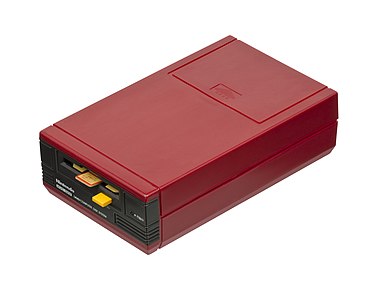任天堂磁碟機
任天堂的磁碟機(Famicom Disk System/ディスクシステム本体),於1986年在日本推出的擴展設備,專門為紅白機(Famicom)設計,用磁碟片作為遊戲的存儲介質。在當時是相當創新且具突破性的產品,主要目的是為了解決紅白機遊戲卡帶容量有限的問題,並且讓玩家可以保存遊戲進度。
主要透過特殊的RAM適配器與Famicom主機相連。使用一種名為「Disk Card」的磁碟片,類似於3.5英寸的軟碟,但稍小,僅能存儲約112KB的數據。這些磁碟片具有可重寫功能,這在當時是個革命性的特點,可以在專門的機構更換遊戲內容,而不必購買新的遊戲卡帶。內部配置自帶的電池供電系統,用來保持RAM適配器中的數據。還設有一個光驅來讀取磁碟片上的數據,通常分為兩面,每面可以存儲一部分遊戲內容,需要根據遊戲提示手動翻轉磁碟來繼續遊戲。
設備的最大優點在於其磁碟片的可重寫特性,這意味著玩家可以以較低的價格購買新的遊戲內容,只需支付少量的寫入費用即可。這也使得遊戲開發者能夠創作更大、更複雜的遊戲,因為磁碟片的存儲容量比當時的卡帶更大。此外,由於磁碟片可重寫,遊戲進度的保存變得更方便,這對於一些需要長時間遊玩的RPG遊戲來說尤為重要。然而,也有不少缺點。首先,磁碟片的讀取速度較慢,導致遊戲載入時間長。其次,磁碟片的保存性較差,容易受潮損壞,這對於耐用性是一個挑戰。此外,本身依賴於內部電池來維持數據,這些電池的壽命有限,隨著時間推移需要更換電池,否則會導致數據丟失。更重要的是,隨著卡帶技術的進步,卡帶的存儲容量逐漸增加,磁碟機的優勢逐漸喪失。
當時在日本市場的銷售非常成功,總共售出大約450萬台,沒有在海外市場推出。該設備推出的經典遊戲有《薩爾達傳說》(The Legend of Zelda)、《超級瑪利歐兄弟2》(Super Mario Bros. 2,日本版,即《夢工場》)、《銀河戰士》(Metroid)等。這些遊戲透過磁碟片的存儲容量和可重寫特性,提供更為豐富的遊戲體驗。
後來逐步被淘汰主要原因在於卡帶技術的飛速發展。隨著存儲技術的進步,卡帶的存儲容量迅速增加,並且讀取速度更快,穩定性也更高。任天堂開始在卡帶中內建電池來保存遊戲進度,這解決磁碟片可重寫的優勢。再加上磁碟片的耐用性問題和使用的繁瑣性,最終使得磁碟機逐漸被市場淘汰。到1990年代初期,該設備已經基本停止生產,後來的經典遊戲如《薩爾達傳說:林克的冒險》(Zelda II : The Adventure of Link)和《超級瑪利歐兄弟3》(Super Mario Bros. 3)都選擇直接在卡帶上發行。最終,這款曾經風靡一時的擴展設備退出歷史舞台,但它為早期的遊戲開發和玩家體驗帶來許多重要的貢獻。
The Famicom Disk System (ディスクシステム本体) was an expansion device released by Nintendo in 1986 exclusively in Japan. It was specifically designed for the Famicom (the Japanese version of the Nintendo Entertainment System, or NES) and used floppy disks as its storage medium for games. At the time, it was a highly innovative and groundbreaking product, primarily created to address the limited storage capacity of Famicom game cartridges and to allow players to save game progress.
The Disk System connected to the Famicom console through a special RAM adapter. It used a type of floppy disk called "Disk Cards," which were similar to 3.5-inch floppy disks but slightly smaller, with a storage capacity of approximately 112 KB. These disks were rewritable, a revolutionary feature at the time, allowing users to rewrite game content at specialized kiosks without having to buy new game cartridges.
The Disk System was powered by an internal battery, which was used to maintain data in the RAM adapter. It also included a disk drive to read data from the disks, which were typically double-sided. Each side could store part of the game, requiring players to manually flip the disk according to in-game prompts to continue playing.
One of the major advantages of the Disk System was the rewritable nature of the disks, which meant that players could purchase new game content at a lower cost, simply by paying a small fee to have the game written onto their existing disk. This feature also allowed game developers to create larger and more complex games, as the disks offered more storage capacity than the cartridges of the time. Additionally, the ability to save game progress on the disk was particularly important for longer RPGs, where saving was essential.
However, the Disk System also had its drawbacks. Firstly, the disk read speeds were relatively slow, leading to longer load times. Secondly, the disks themselves were not very durable and were prone to damage from moisture, making long-term preservation a challenge. Additionally, the system relied on internal batteries to maintain data, but these batteries had a limited lifespan and needed to be replaced over time, or else data could be lost. As cartridge technology advanced, offering increased storage capacity, the advantages of the Disk System began to diminish.
In terms of sales, the Famicom Disk System was quite successful in Japan, selling approximately 4.5 million units, but it was never released in overseas markets. Some of the most iconic games released for the Disk System include "The Legend of Zelda," "Super Mario Bros. 2" (the Japanese version, known as "The Lost Levels" outside Japan), and "Metroid." These games took advantage of the Disk System's storage capacity and rewritable features to provide a richer gaming experience.
The Disk System was gradually phased out as cartridge technology rapidly improved. With advancements in storage technology, cartridges began to offer much more capacity and faster load times, as well as greater stability. Nintendo also started to incorporate batteries directly into cartridges to allow game saves, which negated the Disk System's main advantage of rewritability. Combined with the fragility of the disks and the cumbersome nature of their use, the Disk System eventually became obsolete.
By the early 1990s, production of the Disk System had largely ceased. Later classic games such as "Zelda II: The Adventure of Link" and "Super Mario Bros. 3" were released directly on cartridges. While the Famicom Disk System eventually faded from the gaming landscape, it made significant contributions to early game development and player experience, leaving a lasting legacy in the history of video gaming.
運費計算方式:
貨款滿1000元運費外加90元
貨款1000以下:買1件運費外加 60元,買2件運費外加 70元,
買3件運費外加 80元 ,買4件運費外加 90元
貨到付款外加30元手續費
外島及大陸地區運費另計
付款方式:
線上刷卡:本站採用Paypal線上刷卡
虛擬帳號匯款:屬於您專屬的虛擬帳戶,方便站長查帳使用,本站強力推薦
實體ATM匯款:請將匯款帳號記錄下來至各大銀行ATM提款機轉帳
超商條碼繳費:請列印本站提供的條碼至四大超商繳費
線上轉帳:透過玉山銀行線上ATM轉帳(此系統只支援IE瀏覽器)
貨到付款:本站採用黑貓宅急便貨到付款
其他注意事項:
如需購買線上點數卡請直接跟站長連絡,本站不提供點數卡的線上付款

